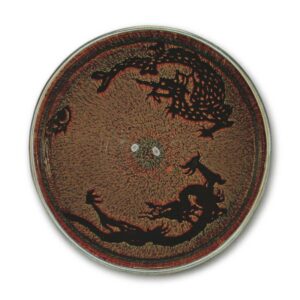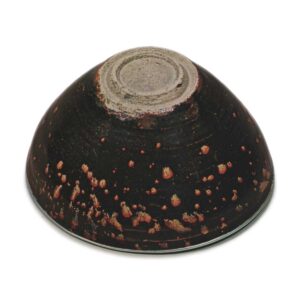

Height: 6.5 – 6.9 cm
Diameter: 13.0 – 13.5 cm
Outer diameter of foot ring: 3.5 cm
Height of foot ring: 0.5 cm
This bowl is unique among tea bowls in that it features a dragon design.
The clay is a dense, grayish-white clay with little yellow in it, and it is fired hard. The bowl is slightly thick, but has a well-proportioned shape and a dignified feel. The lip, which is usually turned up at the rim of a tenmoku tea bowl, is not very noticeable on the outside, but bulges out on the inside, and after showing a slight constriction, it slopes gently towards the interior. The foot is solidly made, with a small but high profile that is not prone to collapsing, unlike the low, small footpads often seen on other pieces. A footpad with such a carefully crafted profile is quite rare.
In addition, the glaze color is also extraordinary. The outside is covered with a glossy blackish brown glaze and sprinkled with straw ash glaze to create a pattern known as “tortoiseshell spots”. The yellowish, caramel-colored and grayish-white spots are generally small and few in number, so the outside glaze surface tends to be dark. In contrast, the inside is covered in a gorgeous seaweed-like straw ash glaze that mixes yellow and blue, and in the middle, two dragons are depicted with their heads turned, looking at a treasure-like object that floats in the black glaze. The dragon patterns were probably made by placing a stencil over the black glaze, sprinkling on the straw ash glaze, and then removing the stencil to reveal the black pattern.
The two dragons are different in appearance. One is a black dragon with four legs, while the other is a dragon with a fish tail, with the scales in white. Such a combination of two dragons is extremely rare, but in China there is the idea that dragons have male and female forms, and the concept of a dragon with a fish tail has existed since ancient times, so it is not surprising that such a design came into being.
Also, the pattern composition of the two dragons being placed in a way that faces the central line is also quite rare. Usually, the two are often expressed in a way that they are turning around each other. However, in the case of this bowl, there are sometimes patterns where the folding branch pattern is placed freely inside the bowl, or where it is decorated with flying dragons. Also, in the later Ming dynasty, there are many examples of what is called “Soryu Chouju”. In any case, compared to the pattern composition of ordinary Song porcelain, it is different, and it is also an excellent design.
The place of manufacture is, needless to say, the Jizhou kilns in Jiangxi Province. The period of manufacture is thought to be the Southern Song dynasty, around the 12th or 13th century.
There is a folk tale that the dragon-patterned tea caddy was used by the emperor of the Tang dynasty, and this is probably because similar items are rare and the design has a dignified feel.
It is flawless, with a silver border around the rim, and it comes with a stand called a “Nigasakidai” (meaning “Nigasaki stand”). This bowl was passed down in the Osaka Konoike family, and in 1873 it was passed from Mr. Zengoro Konoike to the Fujita family, and then passed from one family to another, and is said to have ended up in a certain family in Tokyo.



